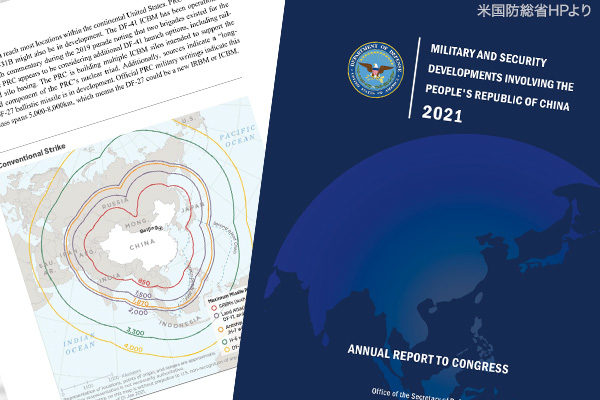China has deployed hypersonic missiles that can reach mainland Japan, according to a report by the U.S. Department of Defense published on November 3. The missiles that the current missile defense system cannot intercept have a particularly great impact on Japan’s national security. Japan should wake up to the threats from the new nuclear-capable missiles and swiftly take measures to counter them.
China has deployed DF-17s on Taiwan Strait coasts
The missile in question is the DF-17, equipped with a hypersonic glide vehicle that can fly at more than five times the speed of sound in the atmosphere. DF-17 missiles began to be deployed in 2020, the Pentagon’s annual report on the Chinese military power said without specifying deployment sites. According to a Hong Kong newspaper story in October 2020, China was fielding DF-17 missiles in Fujian and Zhejiang Provinces facing the Taiwan Strait, replacing old short-range ballistic missiles targeting Taiwan. The Pentagon report virtually confirmed the newspaper story. The DF-17 is a medium-range missile with a range of 1,500 kilometers that can reach not only U.S. bases in Okinawa but the western half of mainland Japan if launched from Chinese bases located right across from Taiwan.
In August this year, China test-fired another hypersonic missile under development to attack a ground target from earth orbit, shaking U.S. military leaders.
Japan’s ballistic missile defense system is designed to intercept missiles when they fly outside the atmosphere or just before their hitting targets after reentering into the atmosphere. But the DF-17 is difficult for the system to intercept because it flies in the atmosphere and does skip glide maneuvers like a thrown stone skipping over water. Even if Japan acquires capabilities to attack enemy bases, it may be difficult for Japan to block DF-17 missiles from being fired because DF-17 launchers are road-mobile, making it impossible to predict launching sites in advance.
Japan thus has almost no means to defend against DF-17 missiles. China has deployed such missiles right across from Taiwan in an apparent bid to prevent U.S. forces and the Japanese Self-Defense Forces from using military bases in Japan to intervene in China’s invasion of Taiwan. A military expert in China described “the primary purpose of the DF-17 as striking foreign military bases and fleets in the Western Pacific,” said the Pentagon report. Even if military bases are targets, missiles could deflect from the course and hit densely populated areas around the bases.
Learn from a forerunner’s wisdom
What should Japan do if it cannot defend against DF-17 with its current missile defense system or with potential capabilities to attack enemy bases? We cannot afford to idly wait until defense technologies against hypersonic missiles become available. DF-17 missiles have already been operationally deployed.
Then, we should learn from the wisdom and courage of a forerunner. During the Cold War, then West German Chancellor Helmut Schmidt spearheaded the North Atlantic Treaty Organization’s double-track decision to deploy in Western Europe missiles countering SS-20 medium-range missiles deployed by the Soviet Union and launch disarmament talks with the Russians, leading to the mutual abolition of medium-range missiles.
As Schmidt courageously decided to accept missile deployment in West Germany, Japanese politicians should have a strong sense of crisis regarding China’s DF-17 deployment. Japan might have no choice but to accept its deployment of medium-range missiles and amend its constitution.
Yasushi Tomiyama is a senior research fellow and Planning Committee member at the Japan Institute for National Fundamentals and a former foreign news editor and bureau chief in Washington, D.C., London and Bangkok for the Jiji Press.


